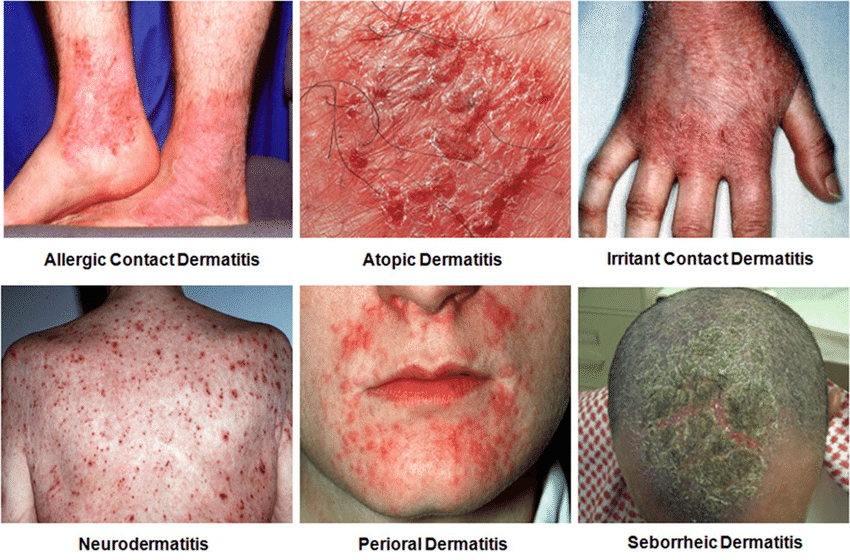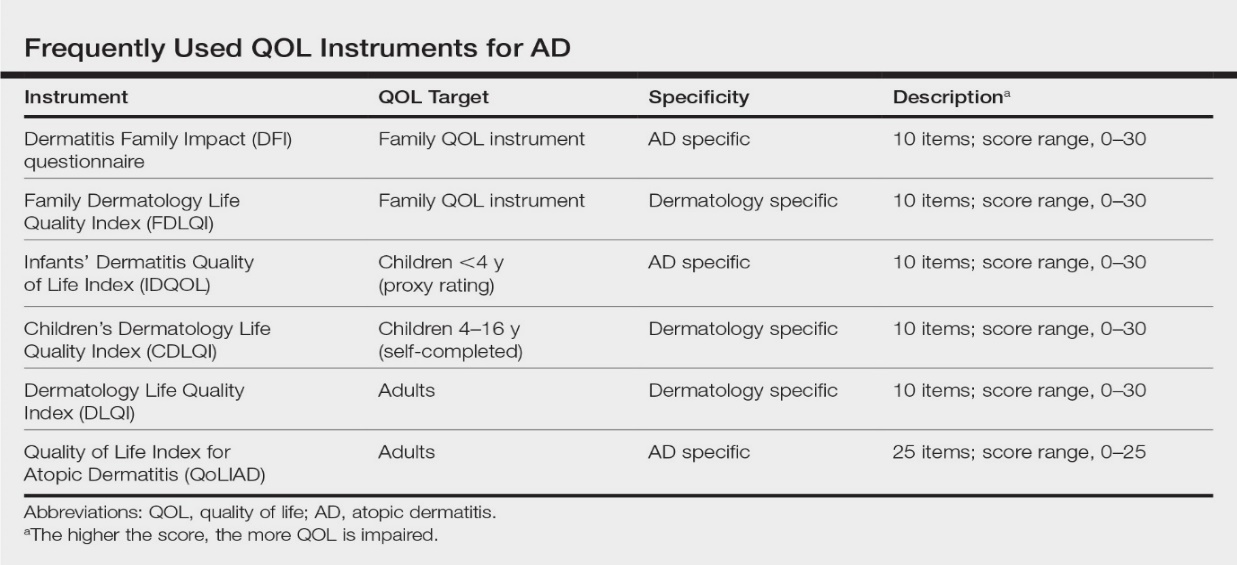
Abstract: Diagnosis of a disease needs keen observation about the presentation of the disease in terms of location, sensation, modalities, concomitant, onset, duration, intensity, frequency, spread, side, size, depth, outcome, stage and the pace of disease episode. Once diagnosis is made then the physician should focus on tools of measuring scales that are widely used by researchers for understanding the impact of disease on the quality of life of the individual. Use of scales aids in perceiving the scope of a particular medicine in a particular disease. Adhering to diagnostic criteria and measuring scales ensures appropriate execution of the planned therapeutic strategy and to arrive at the expected outcome. It helps in increasing the probability of cure and adds evidence to the action taken by the physician for the sake of restoration of the sick to cure as it is termed.
Keywords: Atopic dermatitis, diagnostic evaluation, measuring scales, quality of life.
Abbreviations: AD: atopic dermatitis,aph: aphorism, QoL: quality of life, EASI: eczema area and severity index, dermatitis family impact (DFI), family dermatology life quality index (FDLQI), Infants’ dermatitis quality of life index (IDQOL), children’s dermatology life quality index (CDLQI), quality of life index for atopic dermatitis (QoLIAD).
Introduction:
Individualisation of patient as a person and disease is the core of homoeopathy. It requires various skills and knowledge’s for arriving at individualising examination of a case of disease. Hahnemann had given general directions, of which the practitioner has to bear in mind what is applicable for each individual case. For this, the demands on the physician are nothing but freedom from prejudice and sound senses, attention in observing and fidelity in tracing the picture of the disease. Hahnemann had mentioned the manner in which investigation of acute and chronic diseases has to be done in aph. 83-104 so that the physician should be able to clearly perceive the person and his disease. [1] Apart from the guidelines, there are diagnostic evaluation criteria and assessment measurement scales for evaluating the remedy response.
In medical practise, a variety of assessment scales have been devised for various clinical conditions. The tools have been designed to provide objective measurement of function for screening, evaluating baseline status, monitoring changes over time, determining the effects of interventions, and predicting and documenting outcomes of individuals and populations. [2] Dermatological diseases are common yet difficult to treat due to its cosmetic value, complex clinical presentations and needs, which necessitate a special approach to their evaluation, care and cure. The process of comprehensive care should be multi-dimensional. In addition to the medical diagnostic evaluation, it should determine functional status and quality of life through frequent use of standardised measurement instruments. In this article, tools for diagnostic evaluation and assessment scale for dermatitis has been discussed for adding value to the common clinical condition and improving case report writing.
Diagnostic evaluation: The diagnostic evaluation tool for eczema is used to measure the extent (area) and severity of atopic eczema (eczema area and severity index). [3] In research study, it has been demonstrated that the EASI can be learned quickly and utilized reliably in the assessment of severity and extent of AD. The study showed that there was consistency among the evaluators between consecutive days of evaluation. The study results supported the use of the EASI in clinical trials of therapeutic agents for AD. [4] The diagnostic evaluation covers body regions, scoring of areas of involvement in each areas of involvement in each anatomical region, calculation of intensity, and calculations as per the area involvement.
Table 1: Dignostic evaluation: eczema area and severity index (EASI)
Body regions:
- Head/neck
- Upper limbs
- Trunk
- Lower limbs
Scoring of areas of involvement in each anatomical region (area)
| 0 | 1 | 2 | 3 | 4 | 5 | 6 |
| No eruption | < 10% | 10-29% | 30-49% | 50-69% | 70-89% | 90-100% |
Calculation of Intensity
| Criteria | 0 (Absent) | 1 (Mild: just perceptible) | 2 (Moderate: obvious) | 3 (Severe) |
| Erythema (E) | None | Faintly detectable erythema, very light pink | Dull red, clearly distinguishable | Deep, dark red |
| Infiltration/Papulation (I) | None | Barely perceptible elevation | Clearly perceptible elevation | Extensive elevation |
| Excoriation (Ex) | None | Scant evidence of excoriation No erosion or crust | Several liner mark, some erosion or crust | Many erosive and/or crusty lesions |
| Lichenification (L) | None | Light thickening of skin discernible only by touch | Definite thickening of skin with exaggerated markings and visible criss-cross pattern | Thickened indurated skin and visible exaggerated criss-cross pattern |
Calculations
| Head/Neck | (E + I + Ex + L) x Area x 0.1 (in children 0-7 years (E + I + Ex + L) x Area x 0.2) | |
| Upper Limbs | (E + I + Ex + L) x Area x 0.2 | |
| Trunk | (E + I + Ex + L) x Area x 0.3 | |
| Lower Limbs | (E + I + Ex + L) x Area x 0.4 (in children 0-7 years (E + I + Ex + L) x Area x 0.3) | |
| EASI | Sum of the above four body areas | Total score = |
Measuring scales used for assessment of quality of life: There are six frequently used quality of life instruments for atopic dermatitis (Fig. 1). [4] Each instrument is prepared with a quality of life target (family, children, proxy rating, self-completed and adults) specificity (AD or dermatology specific) and description in terms of number of items (questions) and score range.
Fig 1: Frequently used QoL instruments for atopic dermatitis

- Dermatitis family impact (DFI) questionnaire
The dermatitis family impact questionnaire is a disease-specific measure to assess the impact of atopic eczema on the quality of life (QoL) of the parents and family members of affected children. This questionnaire measures how much having a child with atopic dermatitis affects the quality of life of other (adult) members of the family. It is designed to be completed by adults (aged 16 years or over) who have a child (up to and including the age of 15 years 11 months) in the family with atopic dermatitis. The use of the DFI has revealed the major impact of atopic eczema on the QoL of families of affected children. The strengths of the DFI include wide international experience of its use, defined test-retest reliability, good internal consistency, sensitivity to change, and good construct (convergent) validity. The total score is calculated by summing the score of each question, resulting in a maximum of 30 and a minimum of 0. [5]
- Family dermatology life quality index (FDLQI)
The family dermatology life quality index (FDLQI) is a questionnaire designed for adult (more than 16 years of age) family members or partners of patients (of any age) with any skin disease. It is self-explanatory and can be simply handed to the patient’s family member/partner who is asked to fill it in without the need for detailed explanation. The questions are designed to be completed with a one-month recall period. The total score is calculated by summing the score of each question, resulting in a maximum of 30 and a minimum of 0. [6]
- Infants’ dermatitis quality of life index (IDQOL)
IDQOL is a questionnaire designed for use in infants with atopic dermatitis below the age of four years. It is self-explanatory and should be completed by the child’s parent(s) or regular care taker. The questions are designed to be completed with a one-week recall period. The infants’ dermatitis quality of life index is calculated by summing the score of each question, resulting in a maximum of 30 and a minimum of 0. The higher the score, the more quality of life is impaired. The severity of eczema is scored separately and can be correlated with the infants’ dermatitis quality of life index. [7]
- Children’s dermatology life quality index (CDLQI)
The children’s dermatology life quality index (CDLQI) and the Cartoon CDLQI are designed to measure the impact of any skin disease on the lives of children. The questionnaires are self-explanatory and can be simply handed to the patient who is asked to fill them in with the help of the child’s parent or guardian, as necessary. Both versions of the CDLQI have been validated from the age of four years to 16 years (i.e. up to 15 years and 11 months). The questions relate to the impact of the skin disease on the child over the last week, i.e. over the last seven days. The children’s dermatology life quality index (CDLQI) and the cartoon CDLQI are designed to measure the impact of any skin disease on the lives of children. The questionnaires are self-explanatory and can be simply handed to the patient who is asked to fill them in with the help of the child’s parent or guardian, as necessary. [8]
- Dermatology life quality index (DLQI)
The aim of this questionnaire is to measure how much the skin problem has affected your life OVER THE LAST WEEK. The person has to tick þone box for each question. The questions are based upon how much the skin trouble has affected the person in terms of whether the skin is itchy, sore, stinging, how much the person feels embarrassed or self-conscious, how does it interferes gardening, shopping, sexual activities, studying or working. The questionnaire is designed for use in adults, i.e. patients over the age of 16. It is self- explanatory and can be simply handed to the patient who is asked to fill it in without the need for detailed explanation. It is usually completed in one or two minutes. The DLQI is calculated by summing the score of each question resulting in a maximum of 30 and a minimum of 0. The higher the score, the more quality of life is impaired. [9]
- Quality of life index for atopic dermatitis (QoLIAD)
QoLIAD is a disease specific patient reported outcome which measures the impact that atopic dermatitis (AD) has on a given patient’s quality of life. It is a 25 item questionnaire for patients over the age of 16 with a maximum score of 25 and is restricted to yes or no answers. Higher scores on the QoLIAD indicate a greater negative influence that the disease has on quality of life. The initial version of the QoLIAD had 56 items that reflected the areas of need fulfillment identified in the qualitative interviews as having been affected by AD: mental and emotional stimulation, physical and emotional stability, security, sharing and belonging, self-esteem, personal development and fulfilment. QoLIAD is a practical, reliable, valid and culturally applicable instrument for measuring the impact of AD and its treatment on QoL in clinical trials or in routine clinical practice. [10]
Conclusion:
The diagnostic evaluation and use of assessment scales as part of standard clinical practice in recording the health status of those who are affected due to skin diseases will aid in to improve clinical practise guidelines.
References:
- Hahnemann, S. Organon of Medicine. Noida: B Jain Publishers; 2004.
- Gupta, A., Playfer, J., & Bhowmick, B. (2008). Measurement Scales Used in Elderly Care (1st ed.). CRC Press. https://doi.org/10.1201/9781315380094
- Oakley, P. A. (2015, January). EASI score. EASI score. Eczema area and severity index. Derm Net NZ. Retrieved November 3, 2021, from https://dermnetnz.org/topics/easi-score.
- Hanifin JM, Thurston M, Omoto M, Cherill R, Tofte SJ, Graeber M, Evaluator Group TE. The eczema area and severity index (EASI): assessment of reliability in atopic dermatitis. Experimental dermatology. 2001 Feb;10(1):11-8.
- Koszorú K, Borza J, Gulácsi L, Sárdy M. Quality of life in patients with atopic dermatitis. Cutis. 2019 Sep 1;104(3):174-7.
- Finlay, A. Y. (2019, March 14). Dermatology Life Quality Index. Cardiff.ac.uk. Retrieved November 3, 2021, from https://www.cardiff.ac.uk/medicine/resources/quality-of-life-questionnaires/dermatology-life-quality-index.
- Basra MKA, Sue-Ho R, Finlay AY. The Family Dermatology Life Quality Index; measuring the secondary impact of skin disease. Br J Dermatol 2007; 156: 528-538.
- Lewis-Jones M S, Finlay A Y, Dykes P J. The Infants’ Dermatitis Quality of Life Index. Br J Dermatol 2001; 144: 104-10.
- Lewis-Jones MS, Finlay AY. The Children’s Dermatology Life Quality Index (CDLQI): Initial validation and practical use. British Journal of Dermatology, 1995; 132: 942-949.
- Whalley D, McKenna SP, Dewar AL, Erdman RA, Kohlmann T, Niero M, Cook SA, Crickx B, Herdman MJ, Frech F, Van Assche D. A new instrument for assessing quality of life in atopic dermatitis: international development of the Quality of Life Index for Atopic Dermatitis (QoLIAD). Br J Dermatol. 2004 Feb;150(2):274-83. doi: 10.1111/j.1365-2133.2004.05783. x. PMID: 14996098.





